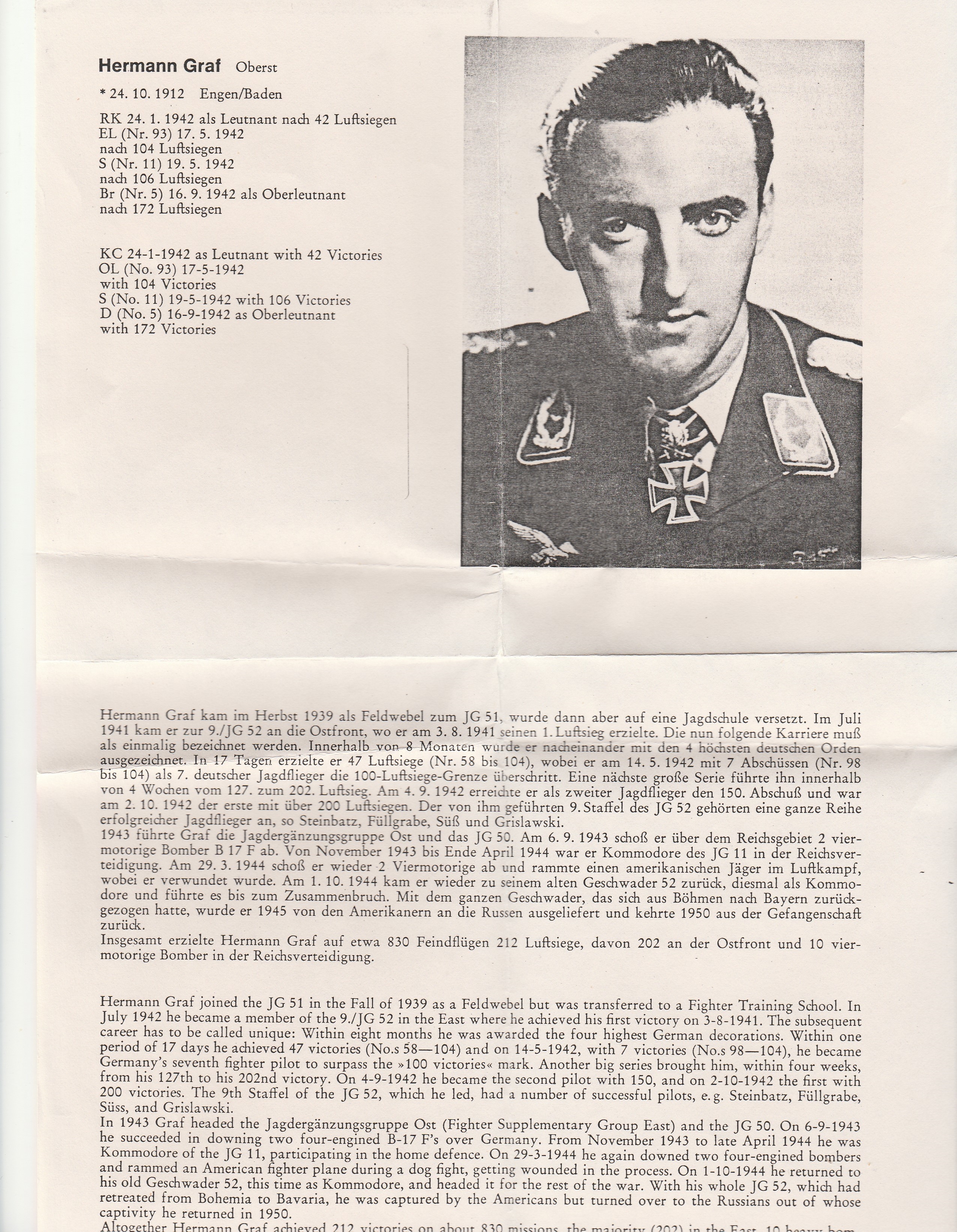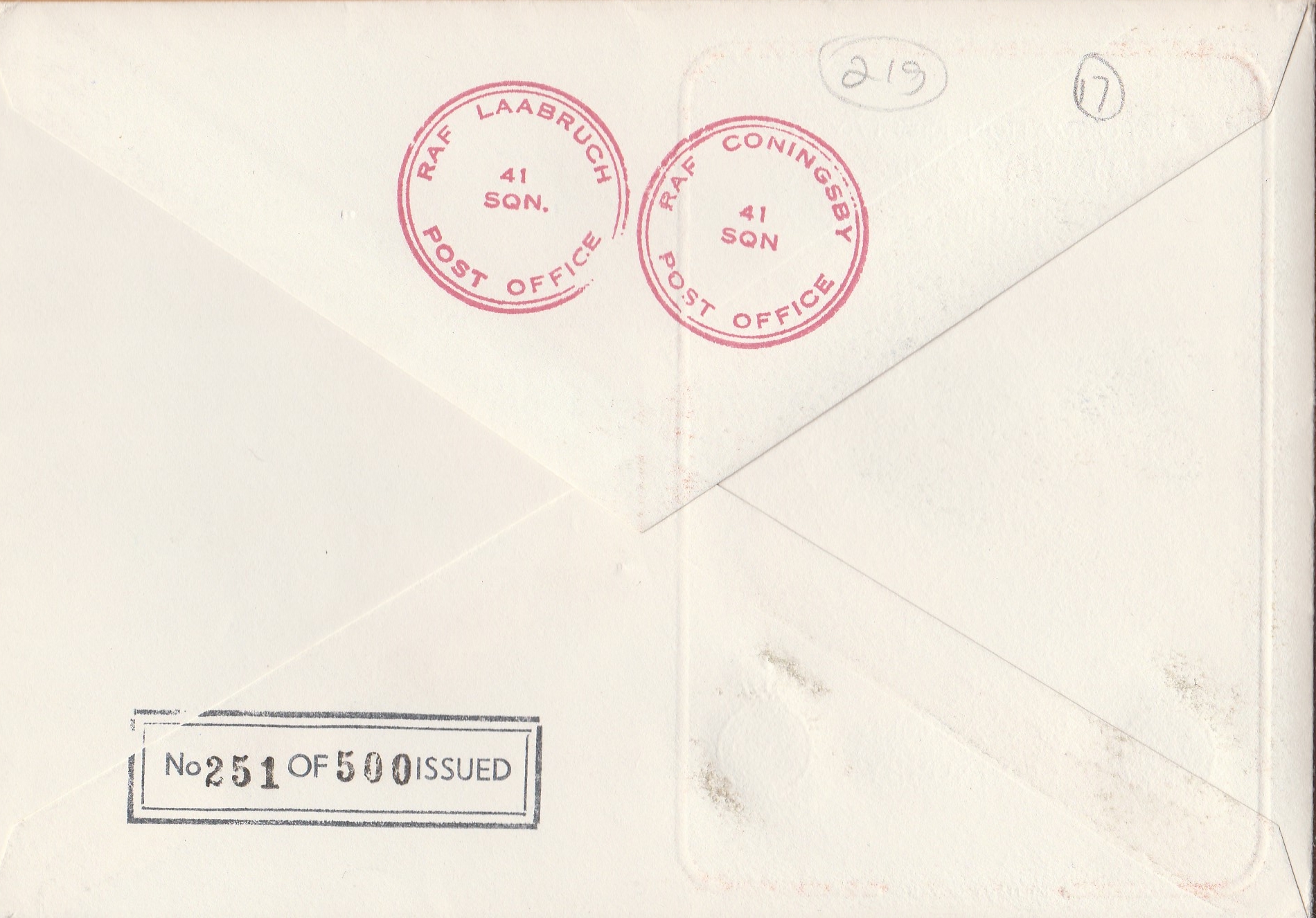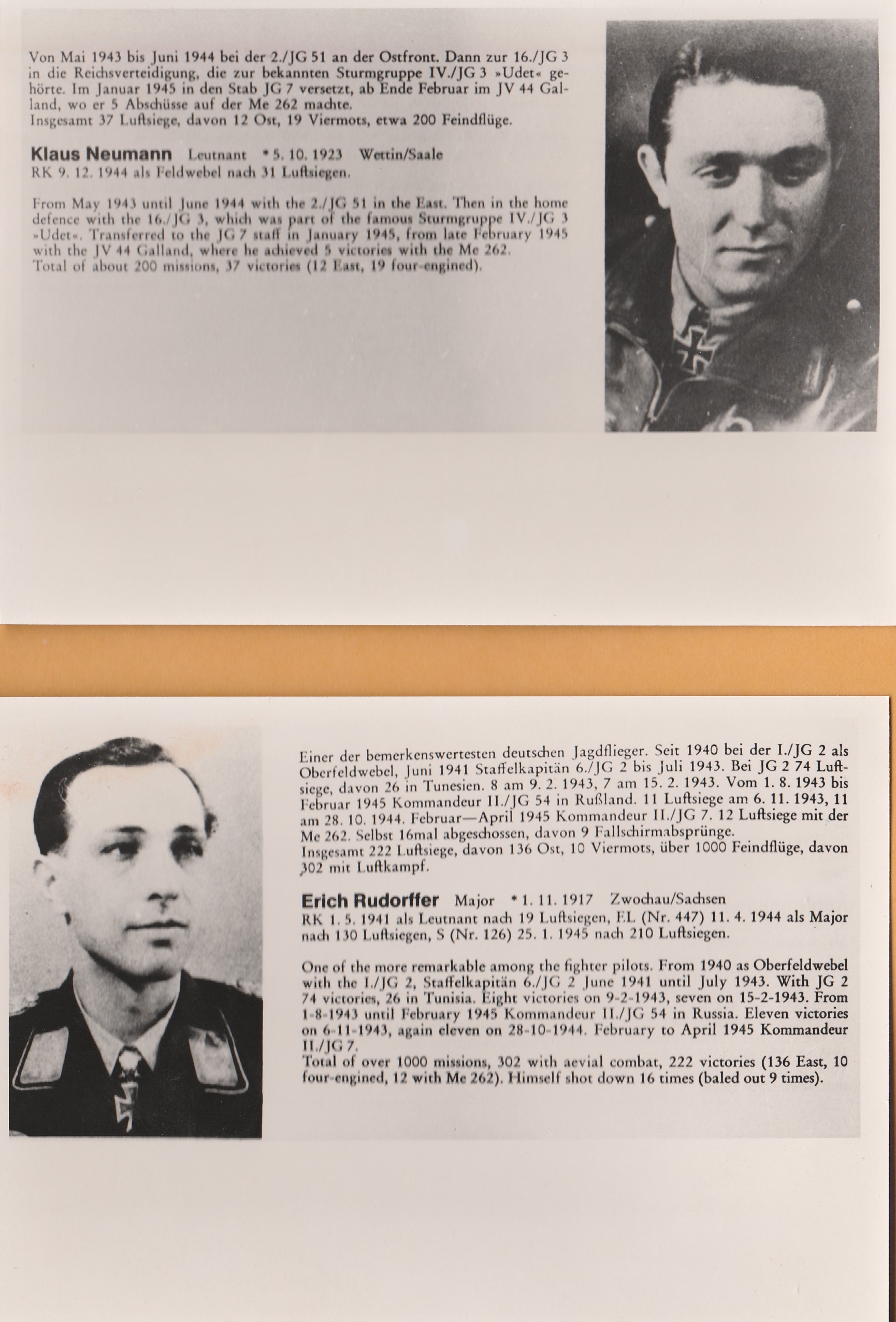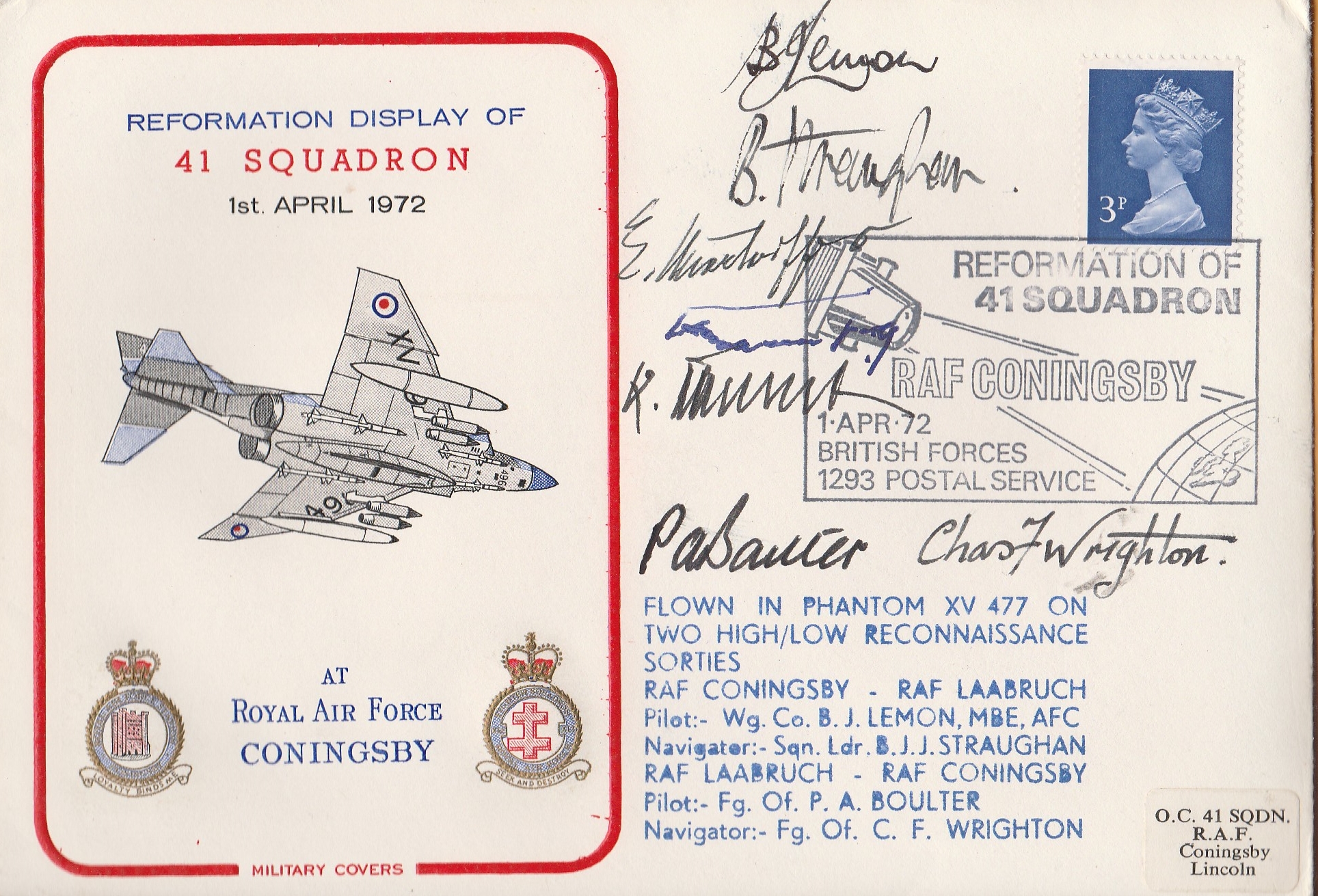



|
~SOLD~GRAF/RUDORFFER/NEUMANN
First Day Signed RAF Commemorative cover 1972 dated signed by Hermann Graf/Erich Rudorffer and Klaus Neumann
Oberleutnant der Reserve
Graf, Hermann
*October 24th, 1912 (Engen/Baden, Germany)
+November 4th, 1988 (Engen/Baden-Württemberg, Germany)
Knights Cross: January 24th, 1942
As: Leutnant der Reserve, Flugzeugführer, 9. Staffel, III. Gruppe, Jagdgeschwader 52
Awarded after 42 aerial victories.
398th Award.
Ritterkreuz mit Eichenlaub: May 19th, 1942
Als: Leutnant der Reserve Staffelkapitän, 9. Staffel, III. Gruppe, Jagdgeschwader 52
Ritterkreuz, Eichenlaub, Schwertern und Brillanten :September 16th, 1942
Als: Oberleutnant der Reserve Staffelkapitän, 9. Staffel, III. Gruppe, Jagdgeschwader 52
Hermann Graf was born on 24 October 1912 at Engen in Baden. As the son of a blacksmith, his modest family origins and poor academic achievements barred access to a military career. He completed an apprenticeship as a locksmith but dropped the trade and took a clerical post at the local municipal offices. He remained in the job until the outbreak of the war. Graf had taken up gliding in 1932, and by 1936 had also qualified as a pilot of powered aircraft. He was also an enthusiastic soccer player. In 1935, Graf applied for flight training with the Luftwaffe. On 2 June 1936, he joined the Fliegerführerschule at Karlsruhe to begin his basic flying training, graduating on 25 September 1936. Graf completed advanced flying training on 31 May 1938. Despite being selected to undergo multi-engine flying training, Graf succeeded in being posted to 2./JG 51, a fighter unit equipped with the Bf 109 E-1, with the rank of Unteroffizier on 31 May 1939. On the outbreak of World War 2, Graf was promoted to the rank of Feldwebel. He flew 21 frontier patrols over the Franco-German border without firing his guns in anger. On 20 January 1940, Graf was transferred as an instructor to Ergänzungs-Jagdgruppe Merseburg. He was promoted to the rank of Leutnant on 1 May. Graf was transferred to JG 52 on 6 October 1940 based at Berlin-Schönwalde. Leutnant Graf was assigned to 9./JG 52. On 14 October, Graf relocated to Rumania with the unit and instructed Rumanian pilots under the auspicies of the German military mission. During this period 9./JG 52 was redesignated 3./JG 28 but was reinstated as 9./JG 52 in late December. In late May 1941, a detachment of III./JG 52 was transferred to Greece to support the invasion of Crete. Graf flew many ground-attck missions over the island. By early June, the detachment had relocated back to Rumania. On 1 August 1941, Graf accompanied 9./JG 52 to the Ukrainian airfield of Biyala Tserkov. On 4 August, he recorded his first victory when he shot down a Russian I-16 fighter during an escort mission for German Ju 87 Stuka dive-bombers against Kiev. On 27 September, his Bf 109 was damaged by return fire from the Russian DB-3 twin-engine bomber he was attacking. Graf managed to bring his damaged aircraft back across the front line and a safe landing. In October, Graf claimed 12 victories, including two Russian fighters shot down on 3 October to record his ninth and 10th victories. In December he again claimed 12 victories, including three enemy aircraft shot down on 6 December (32-34), a further three shot down on 8 December (35-37) and four on 27 December (38-41). Graf was awarded the Ritterkreuz on 24 January after reaching 45 victories. On 23 March 1942, following his 50th victory, Graf was appointed Staffelkapitän of 9./JG 52. His leadership fostered emerging fighter pilots such as Alfred Grislawski (133 victories, RK-EL), Ernst Süss (68 victories, RK, killed in action 20 December 1943), Leopold Steinbatz (99 victories, RK-S, killed in action 15 June 1942) and Heinrich Füllgrabe (67 victories, RK, killed in action 30 January 1945). Graf, began an incredible run of success when, in three weeks, commencing the last week of April, he shot down 48 Russian aircraft. On 30 April, he claimed six victories (64-69), seven on 2 May (70-76), seven on 8 May (79-86), six on 13 May (91-96) and eight on 14 May (97-104). On 17 May 1942, Graf was awarded the Eichenlaub for reaching 104 victories. He was seventh Luftwaffe fighter pilot to achieve 100 victories. The Schwerten (Nr 11) followed two days later, on 19 May 1942, for reaching 106 victories. Graf continued his amazing success during the battles over and around Stalingrad. He claimed 32 victories in August, including four enemy aircraft shot down on 13 August (112-115), five Russian fighters shot down on 14 August (116-120) and a further four Russian fighters shot down on 23 August (130-133). Graf claimed an incredible 62 victories in September, including four on 2 September (141-145), another four on 3 September (146-149), four on 21 September (182-185) and 10 on 23 September (188-197). On 26 September he shot down three enemy aircraft to become the first fighter pilot credited with 200 victories. On 16 September 1942, Oberleutnant Graf was awarded the Brillanten: only the fifth recipient. After achieving his 200th victory he was ordered not to fly operationally. During this period, Graf had had his fair share of close shaves. On 15 September 1942, he had received a cannon hit in the cockpit, on 16 September, he had received 30 hits to his aircraft and on 19 September, his aircraft received hits from ground fire in the wings and, later that day, had half of his rudder shot away. Graf was much feted by the Nazi media. His “star status” was enhanced by his appearances in goal for “die Roten Jäger” or Red Hunters, a Luftwaffe soccer team, which was effectively the German national soccer squad. In the first half of 1943, Graf commanded Ergänzungs-Jagdgruppe Ost, an advanced fighter pilots’ training school, based at Bordeaux in France. On 21 July 1943, Jagdgruppe Süd der ObdL was formed as a high altitude fighter unit to combat RAF Mosquito twin-engine reconnaisance aircraft. On 15 August 1943, the unit was redesignated JG 50. Major Graf was tasked with leading JG 50, a role he performed until the unit was disbanded in October 1943 and absorbed into I./JG 301. Graf was to claim three victories while serving with this unit, including two USAAF B-17 four-engine bombers shot down on 6 September (204-205). Oberst Graf was appointed Kommodore of JG 11 on 11 November 1943. Over the next four months he would be credited with six victories on Reichsverteidigung operations despite being forbidden to take part in combat missions. On 29 March 1944, Graf downed one USAAF P-51 Mustang and rammed another. Wounded, he was forced to bale out of his stricken Bf 109 G-6 (W.Nr. 26 020) “< +”. On 1 October 1944, Oberst Graf was appointed Kommodore of JG 52 based on the Eastern front. He led the unit in a constant retreat through East Prussia, Silesia and Böhmen. He surrendered to American forces at Pisek on 8 May 1945. The Americans, however, promptly handed Graf to Russians. Graf was incarcerated by the Soviets, finally being released on 25 December 1949. Graf was to be heavily criticised by his peers for collaborating with his captors during his five years of imprisonment. Graf became a salesman for an electronics manufacturer and rose to become a Branch Manager in Baden and later Head of Sales. He took up flying becoming a member of the Swiss Aeroclub. From 1965, Graf was afflicted with Parkinson’s disease and he died on 4 November 1988 in his hometown of Engen.
Herman Graf is credited with 212 victories in over 830 missions. He recorded 202 victories over the Eastern Front. Of his 10 victories recorded over the Western front, six were four-engine bombers.
Info from https://www.luftwaffe.cz/graf.html
Neumann, Klaus
*October 5th, 1923 (Wettin, Germany)
+December 10th, 2000 (Mittelhof an der Sieg, Germany)
Knights Cross: December 9th, 1944
As: Feldwebel 16./JG 3 "Udet"
Awarded after 31 aerial victories.
Klaus Neumann was born on 5 October 1923 at Wettin in the Saalkreis region of Sachsen. Unteroffizier Neumann began his combat flying with 2./JG 51 on the Russian front in May 1943. He achieved his first victory on 15 July. He was to record 12 victories over Russia. On 25 June 1944, 2./JG 51 was transferred to Germany where it joined IV./JG 3 becoming 16./JG 3 on 10 August. Neumann was particularly successful against the Allied four-engined bombers. Feldwebel Neumann was awarded the Ritterkreuz on 25 November and had it personally presented to him by Hitler on 9 December 1944. In January 1945, Neumann transferred to JG 7 in a staff position. Here he clashed with the unit’s recently appointed Kommodore, Major Theodor Weissenberger (208 victories, RK-EL). Shortly afterwards Oberst Johannes Steinhoff (176 victories, RK-S) and Oberstleutnant Adolf Galland (104 victories, RK-Br) approached him with an invitation to join JV 44. Leutnant Neumann gained five victories flying the Me 262 jet fighter.
Klaus Neumann was credited with 37 victories achieved in about 200 combat missions. 12 of his victories were recorded over the Eastern front and he shot down 19 four-engined bombers. He was also credited with shooting down five enemy aircraft flying the Me 262 jet fighter.
RUDORFFER Erich
Awarded Knights Cross as Lt.,Flugzeugf.i.d.6./J.G.2 "Richthofen" 1.5.1941
Awarded Oakleaves 11.4.1944
Awarded Swords 25.1. 1945
Luftwaffe fighter pilot who served through the whole of World War II. He was the 7th most successful fighter pilot in the history of air warfare, with 222 victories claimed. Rudorffer fought in all the major German theaters of war, including the European and Mediterranean Theater of Operations and the Eastern Front. During the war he flew more than 1000 combat missions, engaging in aerial combat over 300 times. Rudorffer was shot down by flak and enemy fighters 16 times and had to take to his parachute nine times. He distinguished himself by shooting down 13 enemy planes in 17 minutes. His 222 aerial victories included 58 heavily armoured Il-2 Sturmovik ground attack aircraft.
Price: $0.00
Please contact us before ordering to confirm availability and shipping costs.
Buy now with your credit card
other ways to buy
|


